Alaa Maalouf
Compress to Impress: Efficient LLM Adaptation Using a Single Gradient Step on 100 Samples
Oct 23, 2025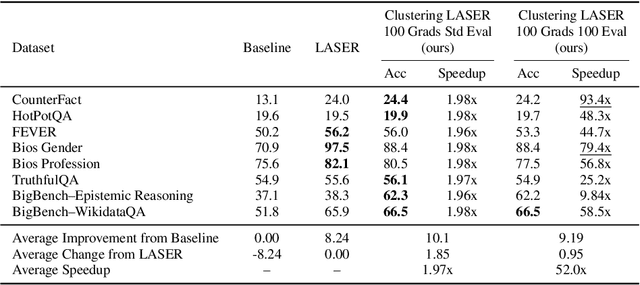
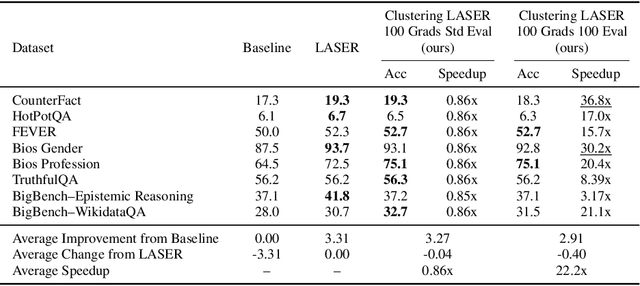
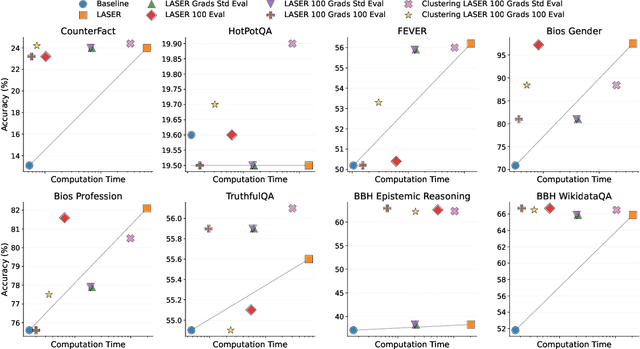

Abstract:Recently, Sharma et al. suggested a method called Layer-SElective-Rank reduction (LASER) which demonstrated that pruning high-order components of carefully chosen LLM's weight matrices can boost downstream accuracy -- without any gradient-based fine-tuning. Yet LASER's exhaustive, per-matrix search (each requiring full-dataset forward passes) makes it impractical for rapid deployment. We demonstrate that this overhead can be removed and find that: (i) Only a small, carefully chosen subset of matrices needs to be inspected -- eliminating the layer-by-layer sweep, (ii) The gradient of each matrix's singular values pinpoints which matrices merit reduction, (iii) Increasing the factorization search space by allowing matrices rows to cluster around multiple subspaces and then decomposing each cluster separately further reduces overfitting on the original training data and further lifts accuracy by up to 24.6 percentage points, and finally, (iv) we discover that evaluating on just 100 samples rather than the full training data -- both for computing the indicative gradients and for measuring the final accuracy -- suffices to further reduce the search time; we explain that as adaptation to downstream tasks is dominated by prompting style, not dataset size. As a result, we show that combining these findings yields a fast and robust adaptation algorithm for downstream tasks. Overall, with a single gradient step on 100 examples and a quick scan of the top candidate layers and factorization techniques, we can adapt LLMs to new datasets -- entirely without fine-tuning.
Decentralized Vision-Based Autonomous Aerial Wildlife Monitoring
Aug 20, 2025



Abstract:Wildlife field operations demand efficient parallel deployment methods to identify and interact with specific individuals, enabling simultaneous collective behavioral analysis, and health and safety interventions. Previous robotics solutions approach the problem from the herd perspective, or are manually operated and limited in scale. We propose a decentralized vision-based multi-quadrotor system for wildlife monitoring that is scalable, low-bandwidth, and sensor-minimal (single onboard RGB camera). Our approach enables robust identification and tracking of large species in their natural habitat. We develop novel vision-based coordination and tracking algorithms designed for dynamic, unstructured environments without reliance on centralized communication or control. We validate our system through real-world experiments, demonstrating reliable deployment in diverse field conditions.
Prompts to Summaries: Zero-Shot Language-Guided Video Summarization
Jun 12, 2025Abstract:The explosive growth of video data intensified the need for flexible user-controllable summarization tools that can operate without domain-specific training data. Existing methods either rely on datasets, limiting generalization, or cannot incorporate user intent expressed in natural language. We introduce Prompts-to-Summaries: the first zero-shot, text-queryable video summarizer that converts off-the-shelf video-language models (VidLMs) captions into user-guided skims via large language models (LLMs) judging, without the use of training data at all, beating all unsupervised and matching supervised methods. Our pipeline (i) segments raw video footage into coherent scenes, (ii) generates rich scene-level descriptions through a memory-efficient, batch-style VidLM prompting scheme that scales to hours-long videos on a single GPU, (iii) leverages an LLM as a judge to assign scene-level importance scores under a carefully crafted prompt, and finally, (iv) propagates those scores to short segments level via two new metrics: consistency (temporal coherency) and uniqueness (novelty), yielding fine-grained frame importance. On SumMe and TVSum, our data-free approach surpasses all prior data-hungry unsupervised methods. It also performs competitively on the Query-Focused Video Summarization (QFVS) benchmark, despite using no training data and the competing methods requiring supervised frame-level importance. To spur further research, we release VidSum-Reason, a new query-driven dataset featuring long-tailed concepts and multi-step reasoning; our framework attains robust F1 scores and serves as the first challenging baseline. Overall, our results demonstrate that pretrained multimodal models, when orchestrated with principled prompting and score propagation, already provide a powerful foundation for universal, text-queryable video summarization.
DataS^3: Dataset Subset Selection for Specialization
Apr 22, 2025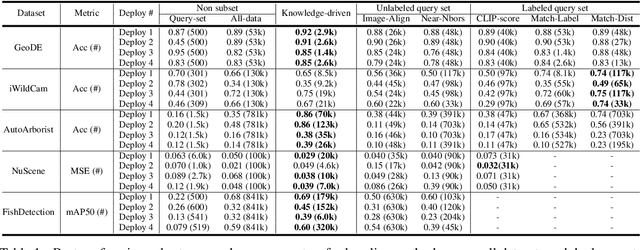

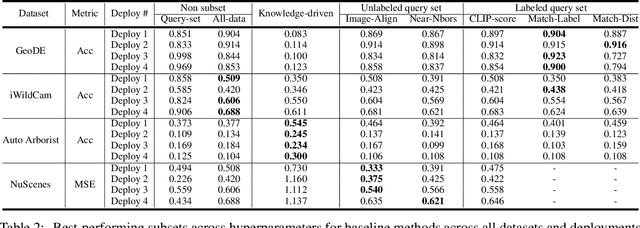
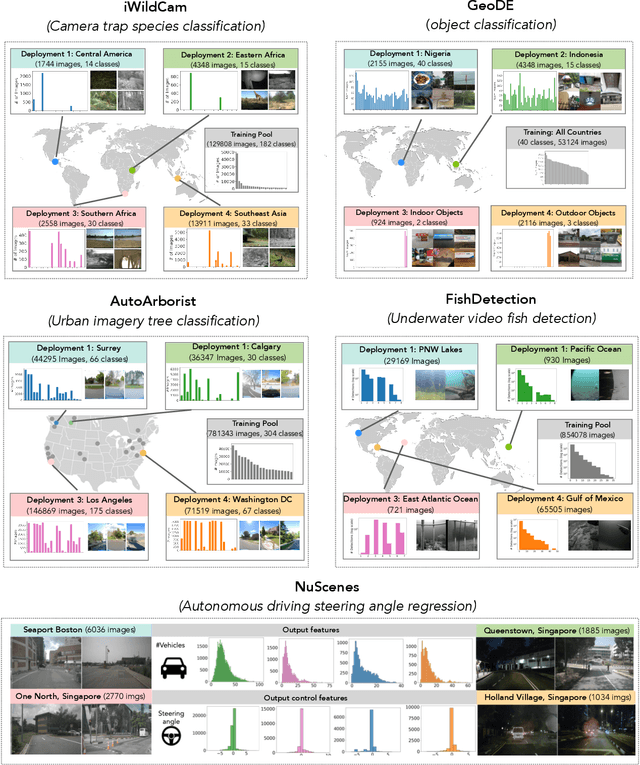
Abstract:In many real-world machine learning (ML) applications (e.g. detecting broken bones in x-ray images, detecting species in camera traps), in practice models need to perform well on specific deployments (e.g. a specific hospital, a specific national park) rather than the domain broadly. However, deployments often have imbalanced, unique data distributions. Discrepancy between the training distribution and the deployment distribution can lead to suboptimal performance, highlighting the need to select deployment-specialized subsets from the available training data. We formalize dataset subset selection for specialization (DS3): given a training set drawn from a general distribution and a (potentially unlabeled) query set drawn from the desired deployment-specific distribution, the goal is to select a subset of the training data that optimizes deployment performance. We introduce DataS^3; the first dataset and benchmark designed specifically for the DS3 problem. DataS^3 encompasses diverse real-world application domains, each with a set of distinct deployments to specialize in. We conduct a comprehensive study evaluating algorithms from various families--including coresets, data filtering, and data curation--on DataS^3, and find that general-distribution methods consistently fail on deployment-specific tasks. Additionally, we demonstrate the existence of manually curated (deployment-specific) expert subsets that outperform training on all available data with accuracy gains up to 51.3 percent. Our benchmark highlights the critical role of tailored dataset curation in enhancing performance and training efficiency on deployment-specific distributions, which we posit will only become more important as global, public datasets become available across domains and ML models are deployed in the real world.
Flex: End-to-End Text-Instructed Visual Navigation with Foundation Models
Oct 16, 2024



Abstract:End-to-end learning directly maps sensory inputs to actions, creating highly integrated and efficient policies for complex robotics tasks. However, such models are tricky to efficiently train and often struggle to generalize beyond their training scenarios, limiting adaptability to new environments, tasks, and concepts. In this work, we investigate the minimal data requirements and architectural adaptations necessary to achieve robust closed-loop performance with vision-based control policies under unseen text instructions and visual distribution shifts. To this end, we design datasets with various levels of data representation richness, refine feature extraction protocols by leveraging multi-modal foundation model encoders, and assess the suitability of different policy network heads. Our findings are synthesized in Flex (Fly-lexically), a framework that uses pre-trained Vision Language Models (VLMs) as frozen patch-wise feature extractors, generating spatially aware embeddings that integrate semantic and visual information. These rich features form the basis for training highly robust downstream policies capable of generalizing across platforms, environments, and text-specified tasks. We demonstrate the effectiveness of this approach on quadrotor fly-to-target tasks, where agents trained via behavior cloning on a small simulated dataset successfully generalize to real-world scenes, handling diverse novel goals and command formulations.
Probing Multimodal LLMs as World Models for Driving
May 09, 2024



Abstract:We provide a sober look at the application of Multimodal Large Language Models (MLLMs) within the domain of autonomous driving and challenge/verify some common assumptions, focusing on their ability to reason and interpret dynamic driving scenarios through sequences of images/frames in a closed-loop control environment. Despite the significant advancements in MLLMs like GPT-4V, their performance in complex, dynamic driving environments remains largely untested and presents a wide area of exploration. We conduct a comprehensive experimental study to evaluate the capability of various MLLMs as world models for driving from the perspective of a fixed in-car camera. Our findings reveal that, while these models proficiently interpret individual images, they struggle significantly with synthesizing coherent narratives or logical sequences across frames depicting dynamic behavior. The experiments demonstrate considerable inaccuracies in predicting (i) basic vehicle dynamics (forward/backward, acceleration/deceleration, turning right or left), (ii) interactions with other road actors (e.g., identifying speeding cars or heavy traffic), (iii) trajectory planning, and (iv) open-set dynamic scene reasoning, suggesting biases in the models' training data. To enable this experimental study we introduce a specialized simulator, DriveSim, designed to generate diverse driving scenarios, providing a platform for evaluating MLLMs in the realms of driving. Additionally, we contribute the full open-source code and a new dataset, "Eval-LLM-Drive", for evaluating MLLMs in driving. Our results highlight a critical gap in the current capabilities of state-of-the-art MLLMs, underscoring the need for enhanced foundation models to improve their applicability in real-world dynamic environments.
Drive Anywhere: Generalizable End-to-end Autonomous Driving with Multi-modal Foundation Models
Oct 26, 2023



Abstract:As autonomous driving technology matures, end-to-end methodologies have emerged as a leading strategy, promising seamless integration from perception to control via deep learning. However, existing systems grapple with challenges such as unexpected open set environments and the complexity of black-box models. At the same time, the evolution of deep learning introduces larger, multimodal foundational models, offering multi-modal visual and textual understanding. In this paper, we harness these multimodal foundation models to enhance the robustness and adaptability of autonomous driving systems, enabling out-of-distribution, end-to-end, multimodal, and more explainable autonomy. Specifically, we present an approach to apply end-to-end open-set (any environment/scene) autonomous driving that is capable of providing driving decisions from representations queryable by image and text. To do so, we introduce a method to extract nuanced spatial (pixel/patch-aligned) features from transformers to enable the encapsulation of both spatial and semantic features. Our approach (i) demonstrates unparalleled results in diverse tests while achieving significantly greater robustness in out-of-distribution situations, and (ii) allows the incorporation of latent space simulation (via text) for improved training (data augmentation via text) and policy debugging. We encourage the reader to check our explainer video at https://www.youtube.com/watch?v=4n-DJf8vXxo&feature=youtu.be and to view the code and demos on our project webpage at https://drive-anywhere.github.io/.
Follow Anything: Open-set detection, tracking, and following in real-time
Aug 10, 2023



Abstract:Tracking and following objects of interest is critical to several robotics use cases, ranging from industrial automation to logistics and warehousing, to healthcare and security. In this paper, we present a robotic system to detect, track, and follow any object in real-time. Our approach, dubbed ``follow anything'' (FAn), is an open-vocabulary and multimodal model -- it is not restricted to concepts seen at training time and can be applied to novel classes at inference time using text, images, or click queries. Leveraging rich visual descriptors from large-scale pre-trained models (foundation models), FAn can detect and segment objects by matching multimodal queries (text, images, clicks) against an input image sequence. These detected and segmented objects are tracked across image frames, all while accounting for occlusion and object re-emergence. We demonstrate FAn on a real-world robotic system (a micro aerial vehicle) and report its ability to seamlessly follow the objects of interest in a real-time control loop. FAn can be deployed on a laptop with a lightweight (6-8 GB) graphics card, achieving a throughput of 6-20 frames per second. To enable rapid adoption, deployment, and extensibility, we open-source all our code on our project webpage at https://github.com/alaamaalouf/FollowAnything . We also encourage the reader the watch our 5-minutes explainer video in this https://www.youtube.com/watch?v=6Mgt3EPytrw .
Dataset Distillation Meets Provable Subset Selection
Jul 16, 2023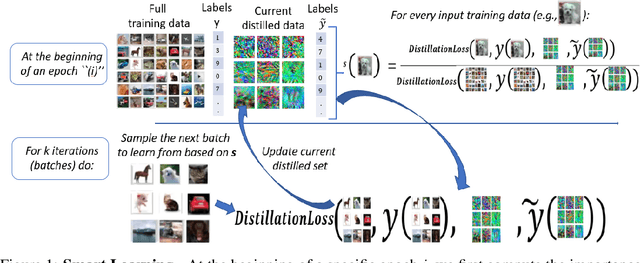
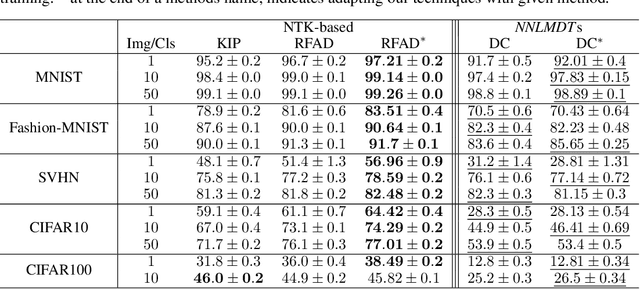


Abstract:Deep learning has grown tremendously over recent years, yielding state-of-the-art results in various fields. However, training such models requires huge amounts of data, increasing the computational time and cost. To address this, dataset distillation was proposed to compress a large training dataset into a smaller synthetic one that retains its performance -- this is usually done by (1) uniformly initializing a synthetic set and (2) iteratively updating/learning this set according to a predefined loss by uniformly sampling instances from the full data. In this paper, we improve both phases of dataset distillation: (1) we present a provable, sampling-based approach for initializing the distilled set by identifying important and removing redundant points in the data, and (2) we further merge the idea of data subset selection with dataset distillation, by training the distilled set on ``important'' sampled points during the training procedure instead of randomly sampling the next batch. To do so, we define the notion of importance based on the relative contribution of instances with respect to two different loss functions, i.e., one for the initialization phase (a kernel fitting function for kernel ridge regression and $K$-means based loss function for any other distillation method), and the relative cross-entropy loss (or any other predefined loss) function for the training phase. Finally, we provide experimental results showing how our method can latch on to existing dataset distillation techniques and improve their performance.
On the Size and Approximation Error of Distilled Sets
May 23, 2023
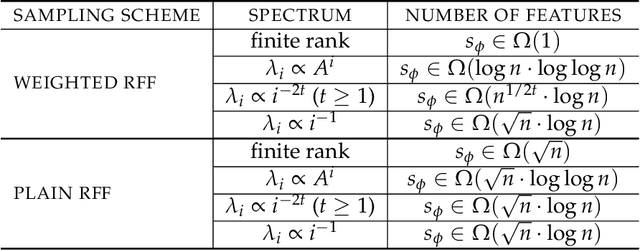
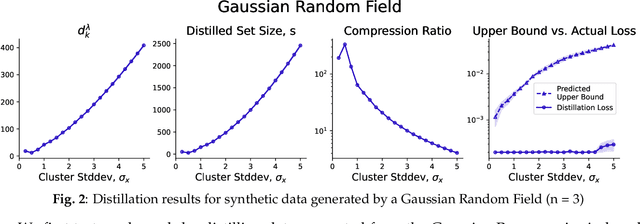

Abstract:Dataset Distillation is the task of synthesizing small datasets from large ones while still retaining comparable predictive accuracy to the original uncompressed dataset. Despite significant empirical progress in recent years, there is little understanding of the theoretical limitations/guarantees of dataset distillation, specifically, what excess risk is achieved by distillation compared to the original dataset, and how large are distilled datasets? In this work, we take a theoretical view on kernel ridge regression (KRR) based methods of dataset distillation such as Kernel Inducing Points. By transforming ridge regression in random Fourier features (RFF) space, we provide the first proof of the existence of small (size) distilled datasets and their corresponding excess risk for shift-invariant kernels. We prove that a small set of instances exists in the original input space such that its solution in the RFF space coincides with the solution of the original data. We further show that a KRR solution can be generated using this distilled set of instances which gives an approximation towards the KRR solution optimized on the full input data. The size of this set is linear in the dimension of the RFF space of the input set or alternatively near linear in the number of effective degrees of freedom, which is a function of the kernel, number of datapoints, and the regularization parameter $\lambda$. The error bound of this distilled set is also a function of $\lambda$. We verify our bounds analytically and empirically.
 Add to Chrome
Add to Chrome Add to Firefox
Add to Firefox Add to Edge
Add to Edge